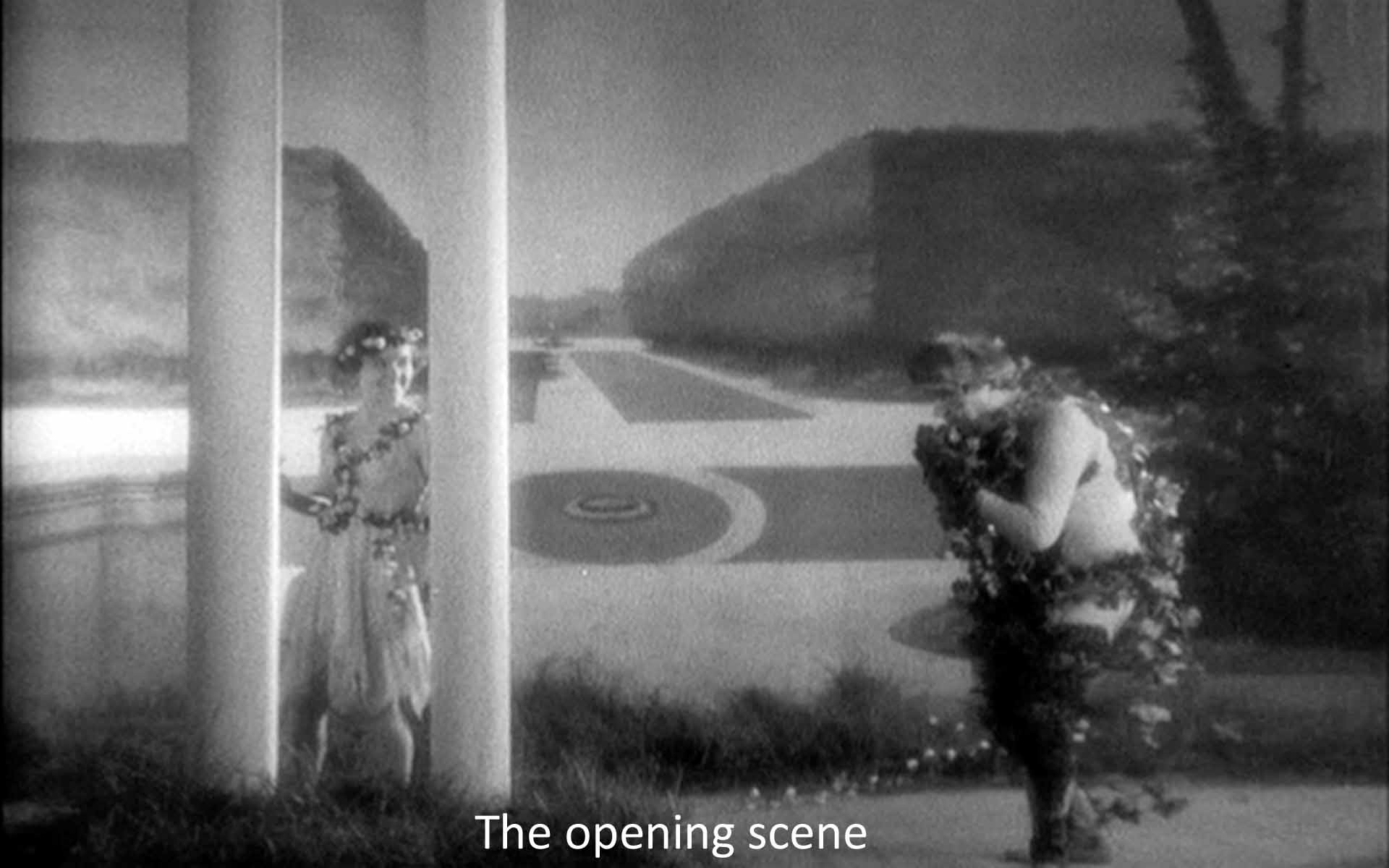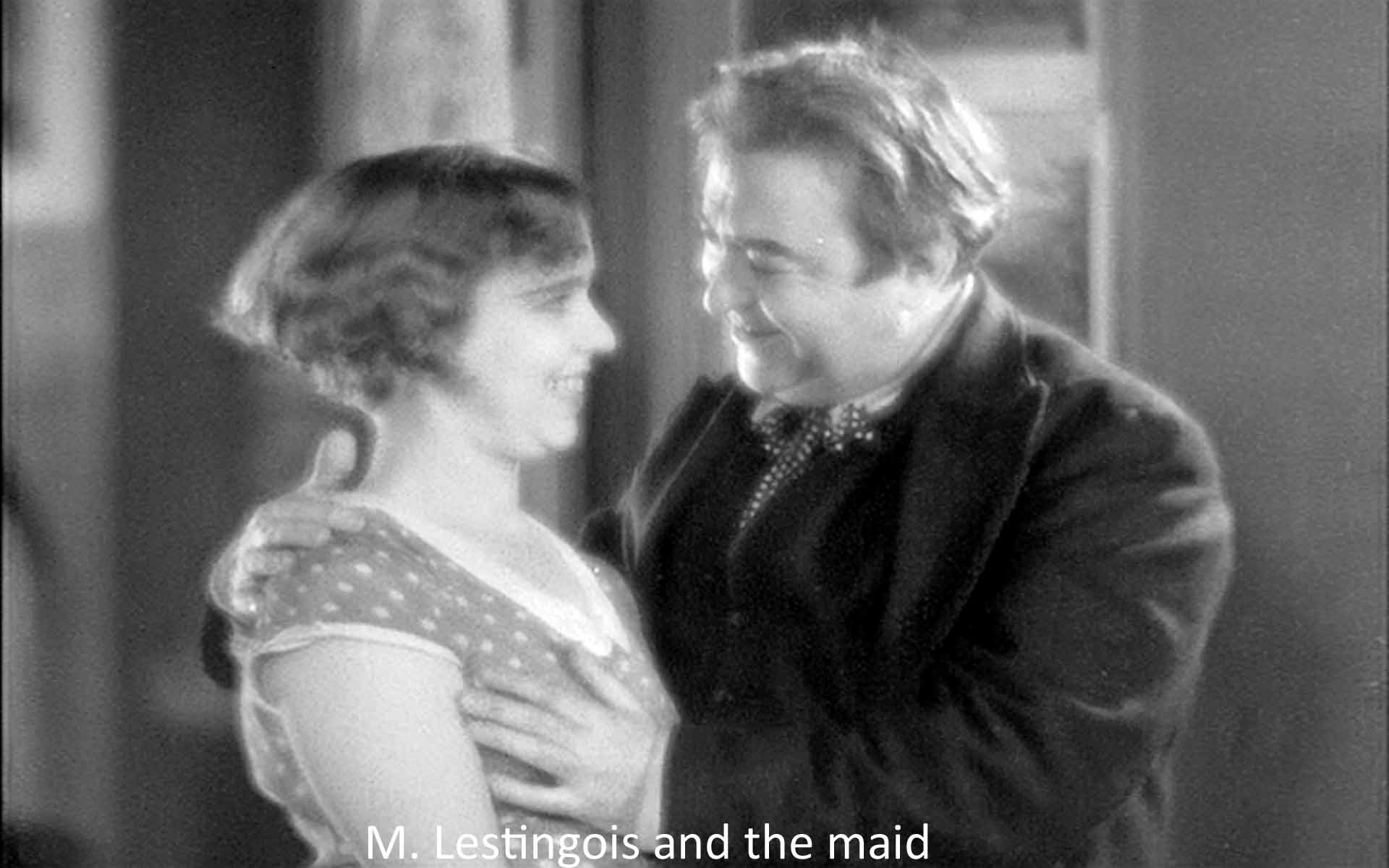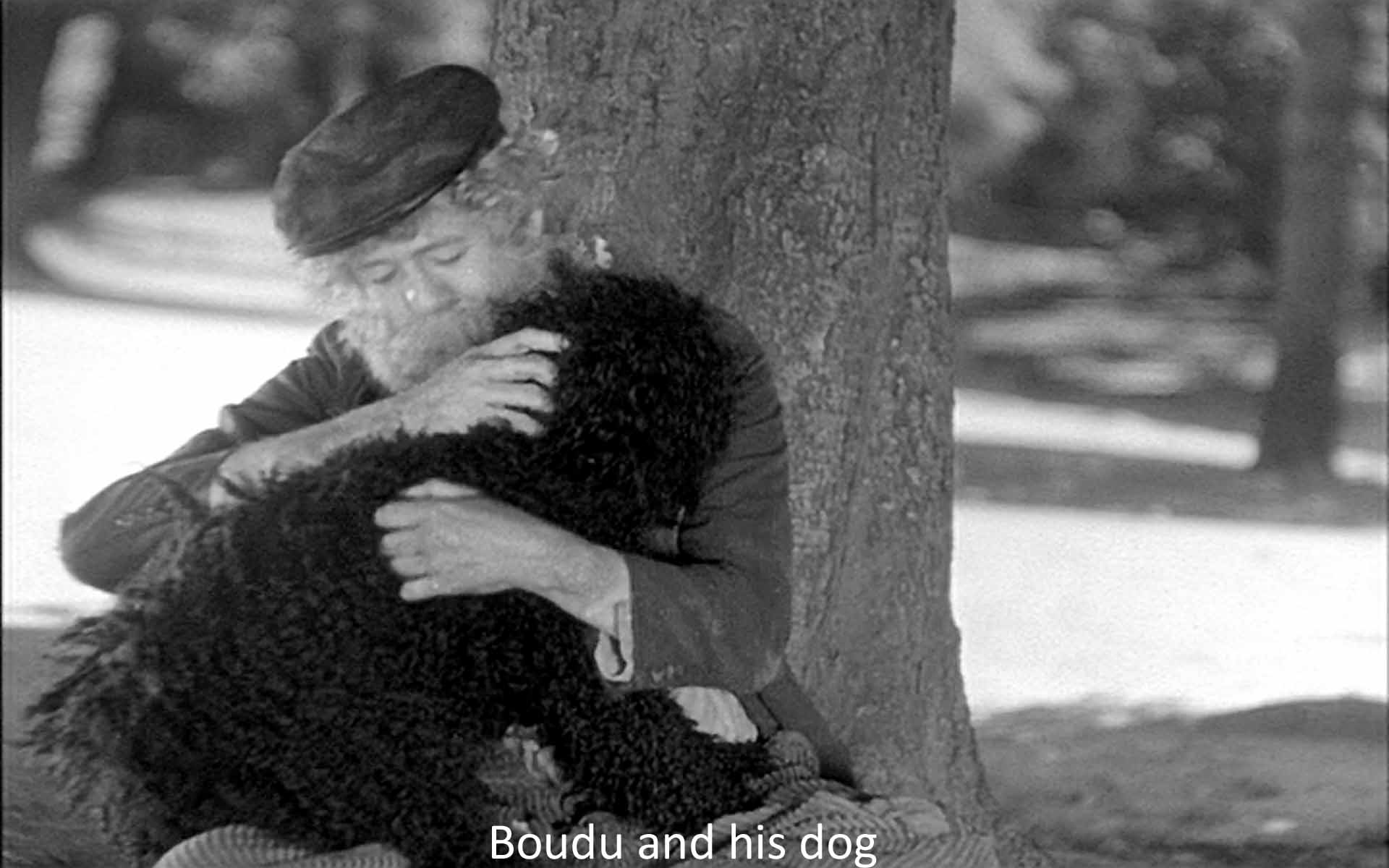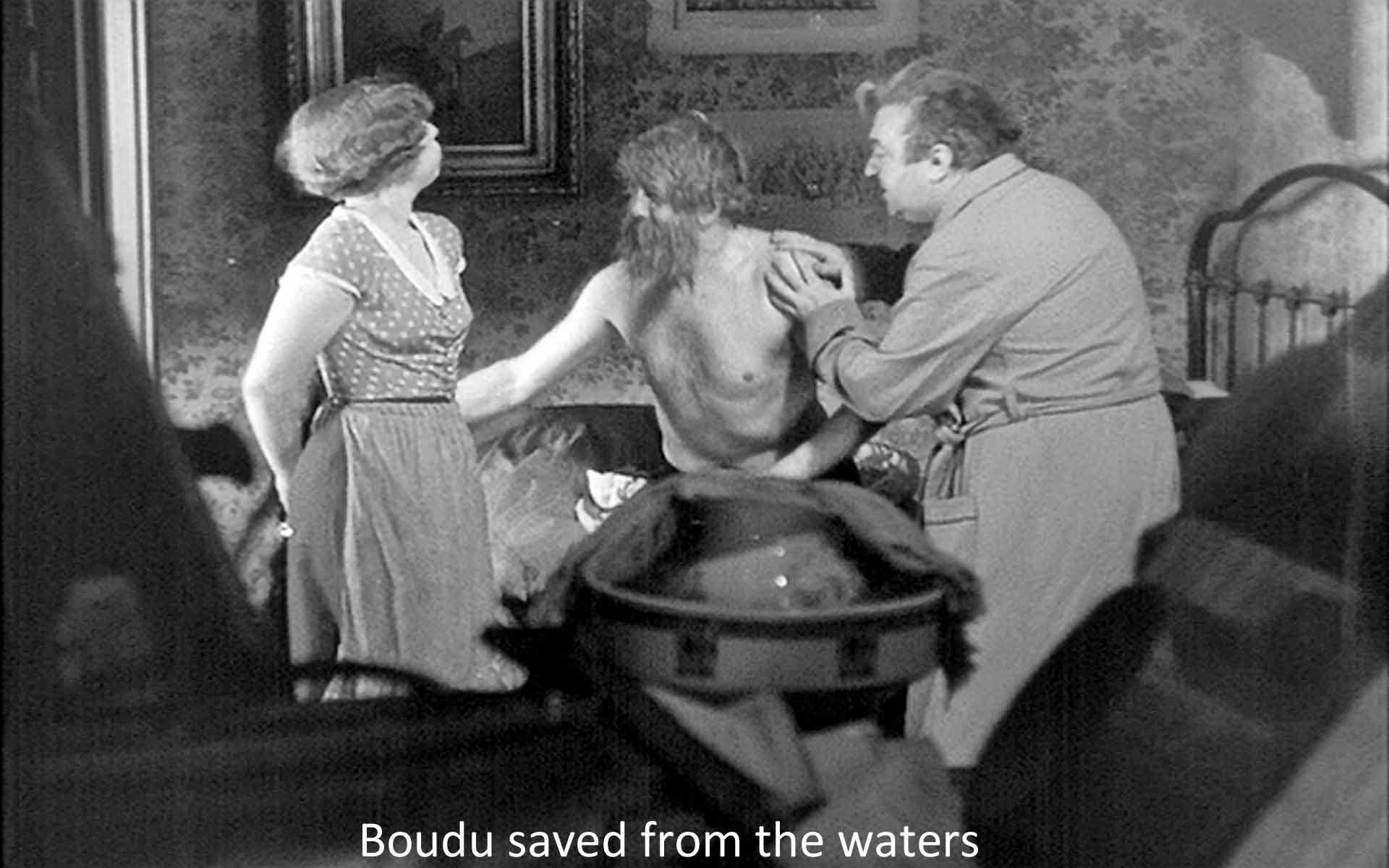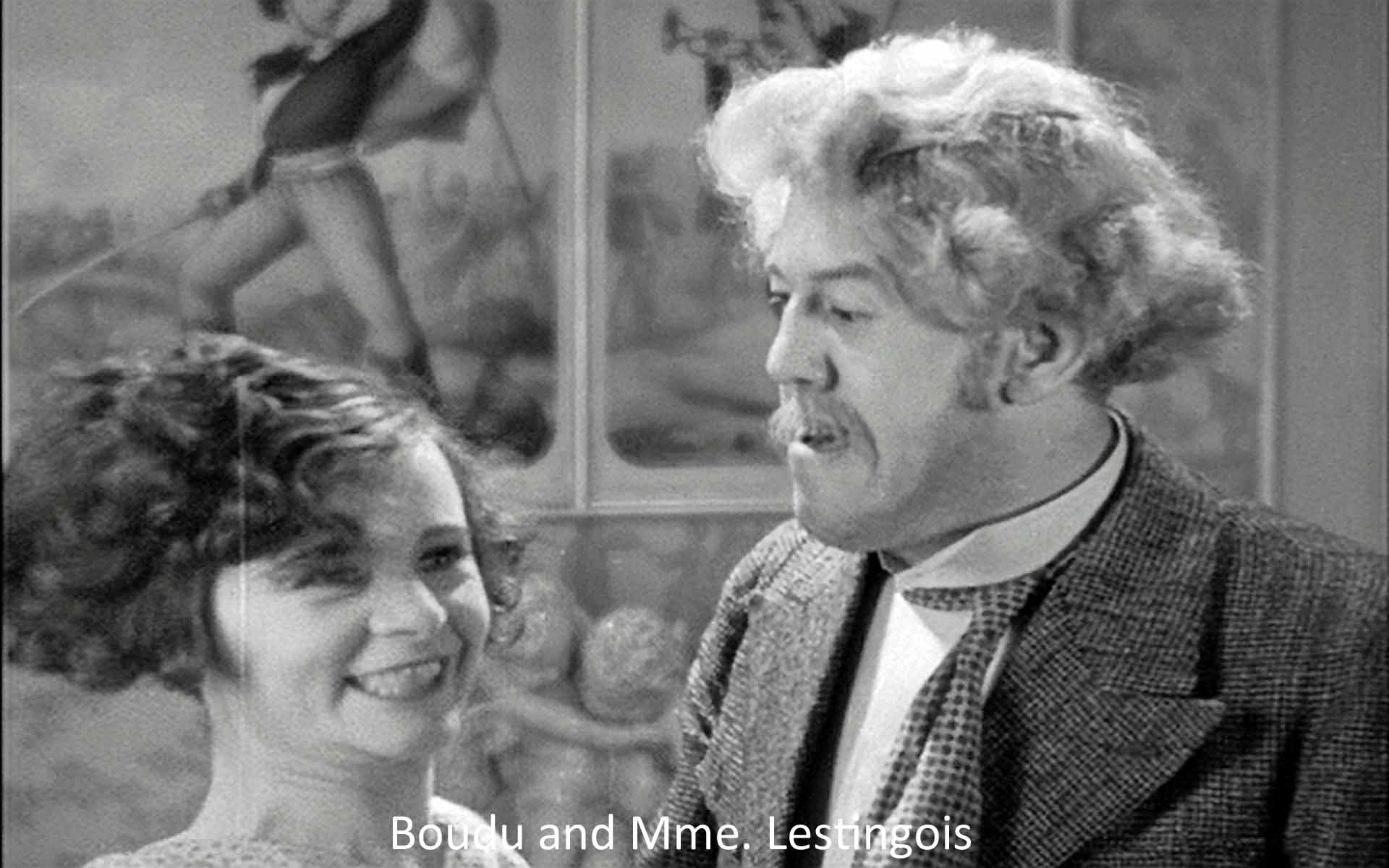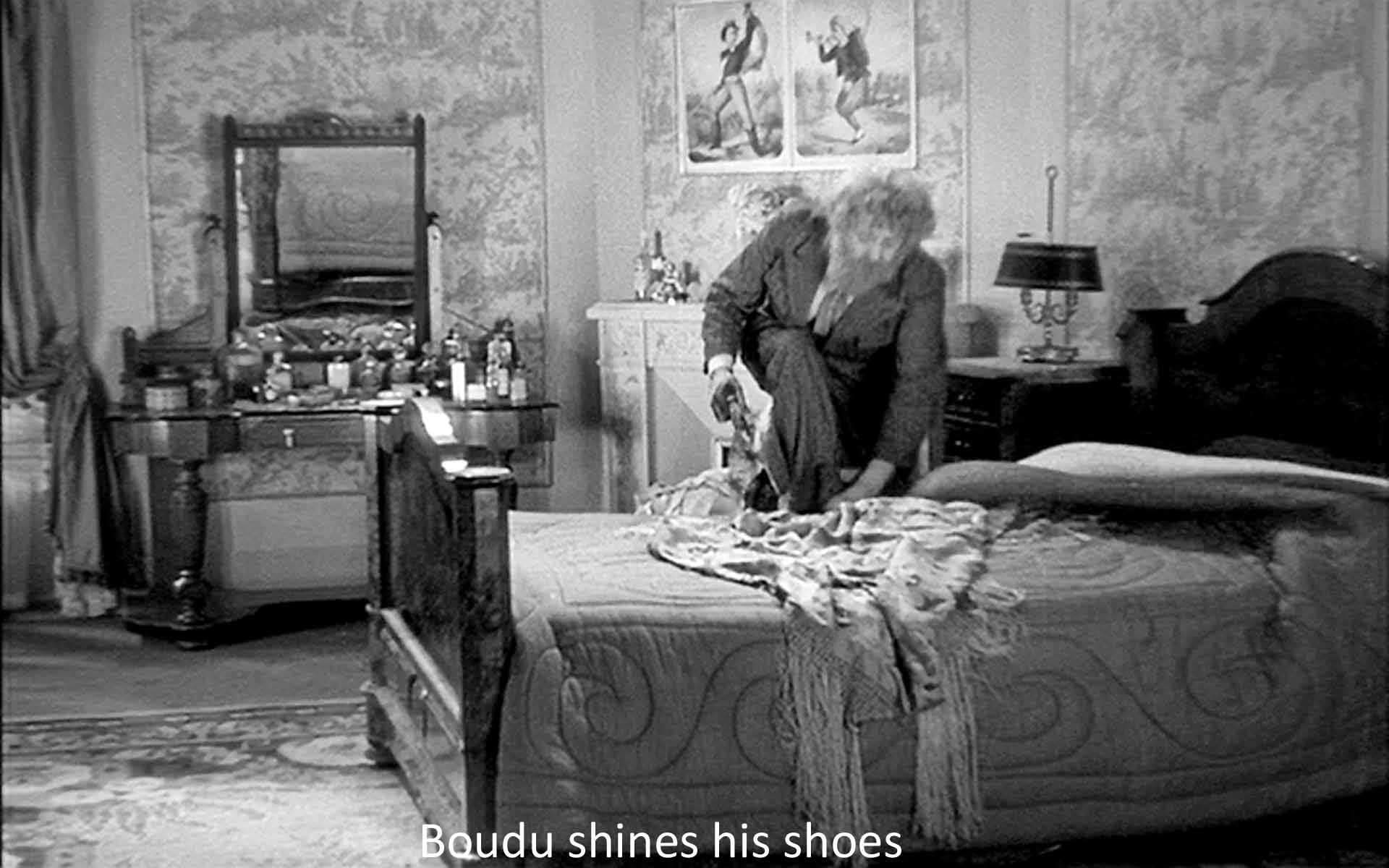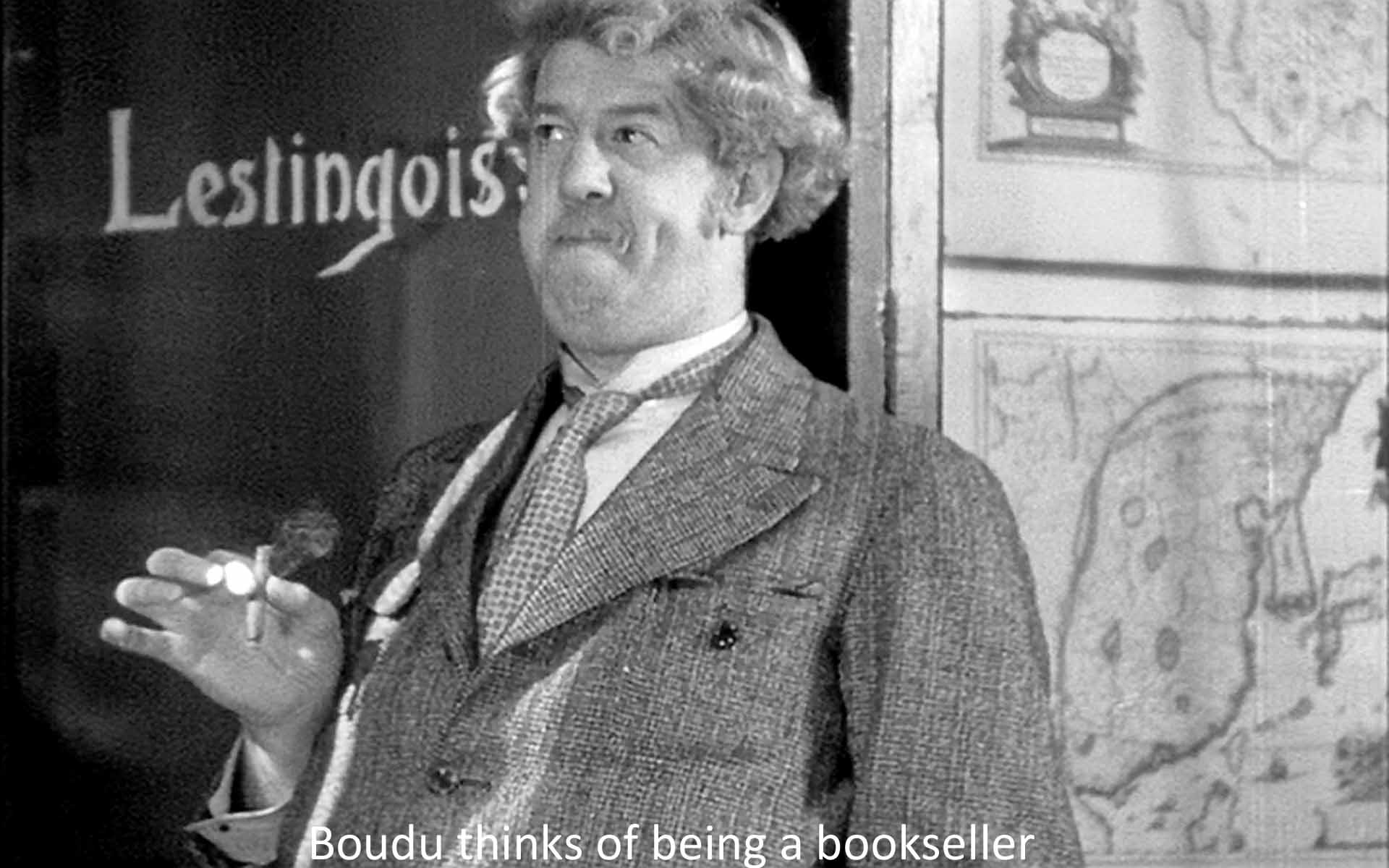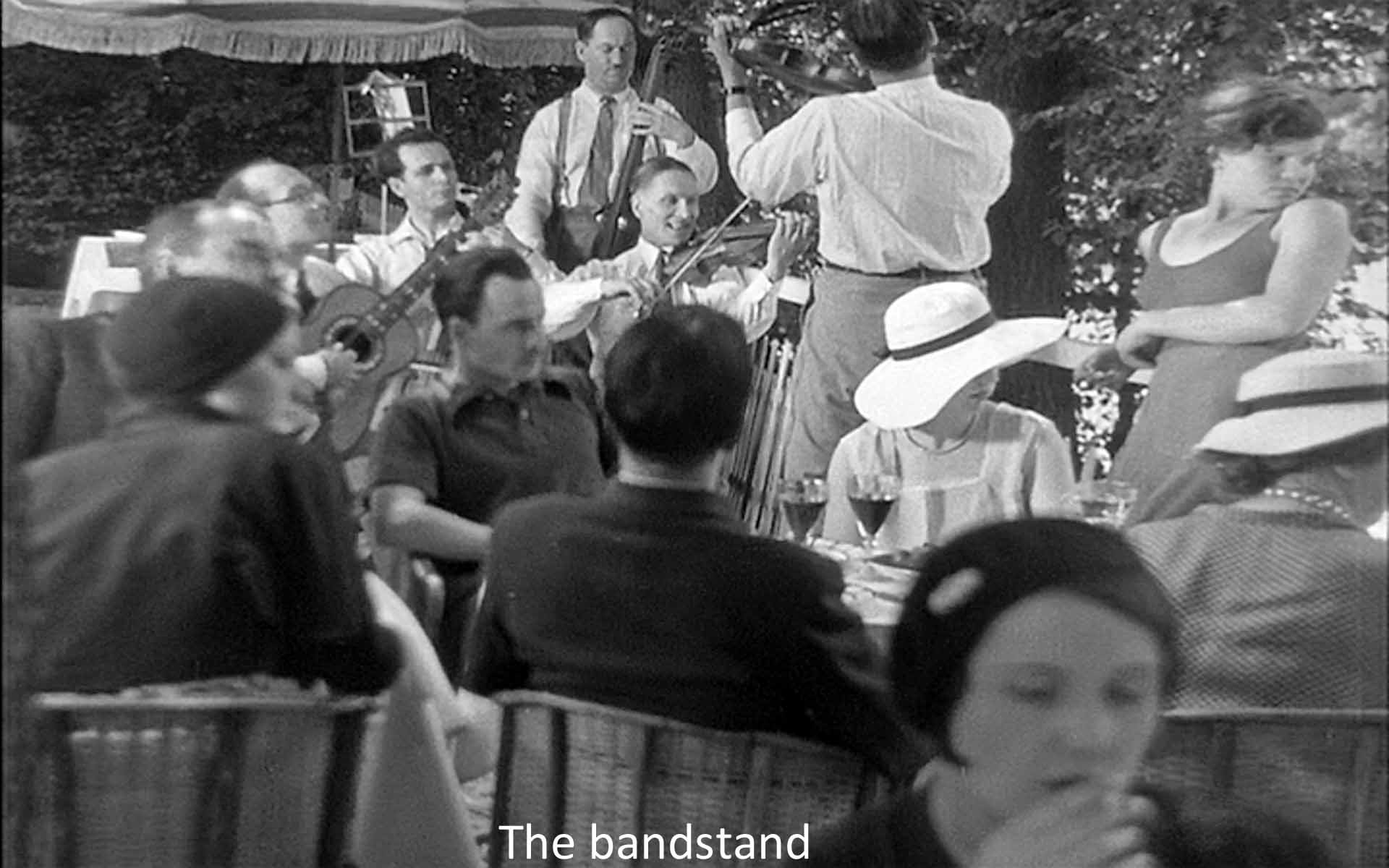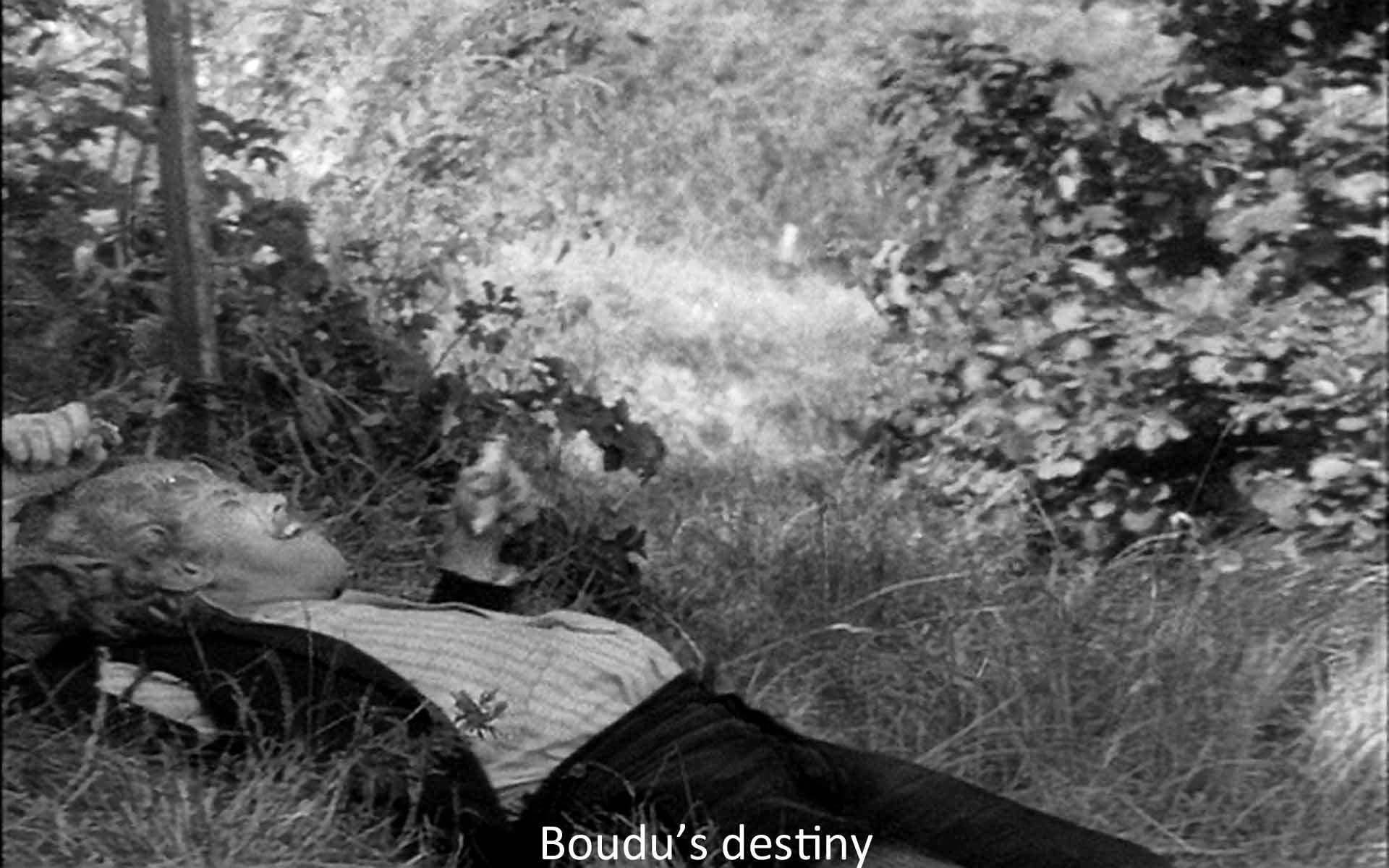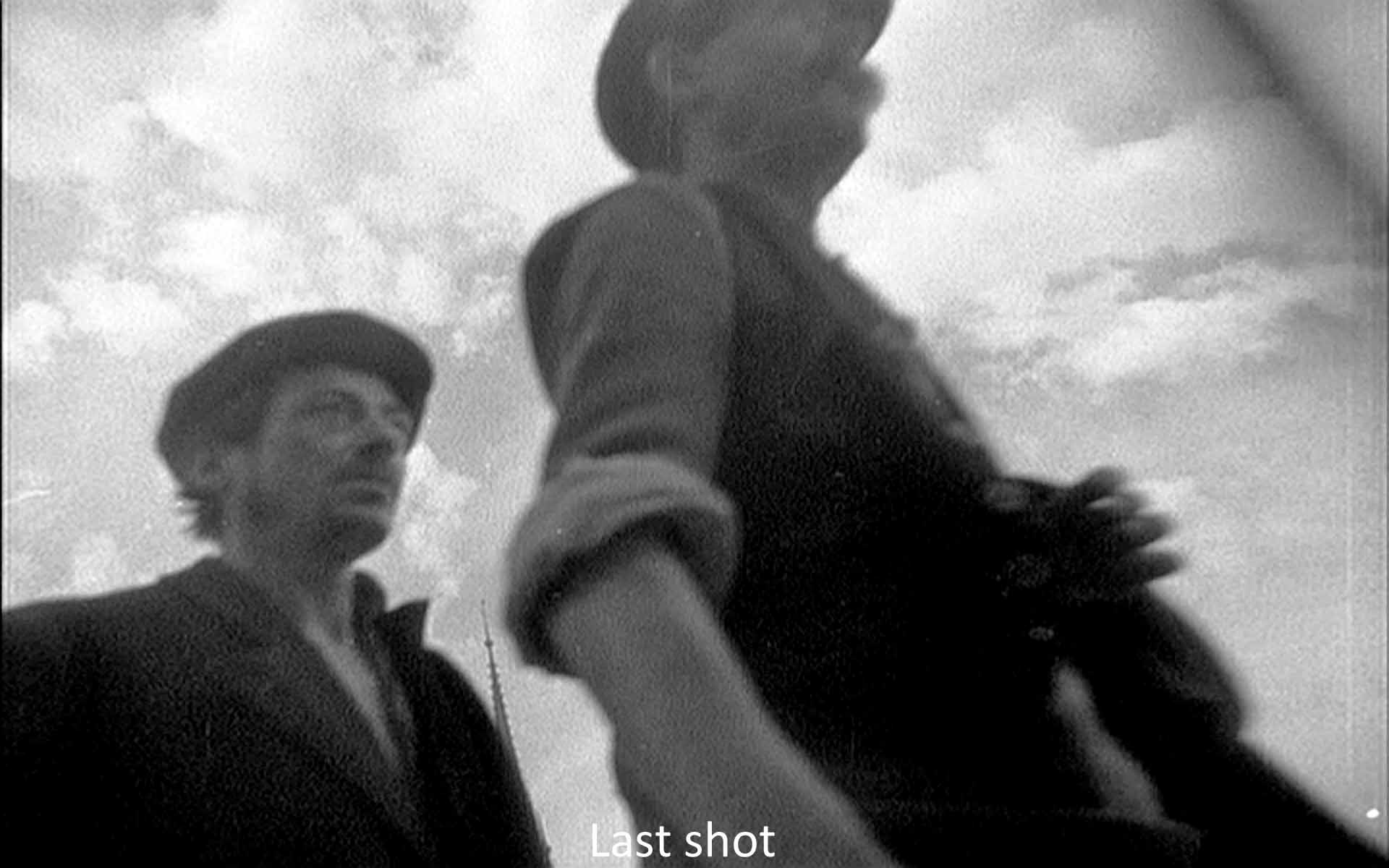Like a lot of art movies, this old-timer answers to a question: Whatever happened to Boudu’s dog? Indeed, why was the dog in the film at all? It is forgotten after the first few minutes. I’ll come back to that. Another way of opening up a movie, any movie, is to look at its opening and close. Surely the director created these shots and scenes with extra care.
This film ends with a shot that has nothing to do with the plot that has gone before, a classic 1930s shot up at a line of marching men. Here they are tramps, clochards, and they are singing “Sur les bords de la Riviera” (On the shores of the Riviera), a celebration of love and luxury and the theme song of this film. (We have just left the bourgeois hero of the film hugging his mistress and his wife.) “On the Riviera”? Tramps in love? Tramps going to the Riviera where the fat cats play? Surely these are inconsistent.
The film’s opening shot also has nothing (and everything) to do with the plot. Renoir first shows us a phony stage set on which a stylized satyr, complete with pipes of Pan, is chasing and eventually catching a nymph.
In the opening and close, Renoir is giving us scenes that play altogether outside the film itself: a stage that is not an illusion; tramps who have nothing but sing of love and the Riviera. And in the second scene the film cuts abruptly to a bust of Voltaire in the bookstore of M. Lestingois (Charles Granval) where that fat, middle-aged bourgeois is playing the satyr’s part with Anne-Marie, the maid (Sévérine Lerczinska) as they have just played satyr and nymph onstage. The stage image is quite phony, suggesting that Lesgingois’ image of himself as sexy is equally phony.
Nevertheless M. Lestingois delights Anne-Marie with his flowery, literary compliments while a friend, a fat flautist, plays upstairs, supplying the music we heard in the stagy pastoral. We have jumped from a comical classical pastoral to a comical modern equivalent, and Renoir has given us another contrast, classical vs. modern. Further, by the end of the introduction, he has introduced two styles that (following Nietzsche) we name by the Greek gods that represent them.
The Apollonian is M. Lestingois with his Voltaire, his reasonableness, his liberal nature, and his faith in the natural man à la Rousseau. And now we get the Dionysiac—Boudu. Cut to a park and a mother scooping up her little boy and his toy boat to go home. (A major image in this and other Renoir films film is water.) They pass Boudu the tramp nuzzling his dog as the two of them relax in a park (a hint at Boudu’s animal nature; in his last scene he feeds a goat). The dog runs away, and Boudu cannot find him and wanders about despairingly. (Boudu is played by the great Michel Simon whose appearance as a tramp in an earlier Renoir movie, La chienne [The Bitch, 1931] inspired the director to make this film.) Throughout, Boudu is grumpy, rude, unruly, and grabby, a creature of appetites for food and sex. He is, in short, Dionysiac, Dionysus being the god of laughter, theater (and presumably movies), drunkenness, ungoverned passion, in short, the irrational, the opposite of rational, serene Apollo and M. Lestingois.
It seems to me that Boudu with his dog gives us the two biggest themes of the film. To be sure, M. Lestingois has amply demonstrated them already, as has the boy with his toy boat and the mother with the boy, as has the stage scene of the nymph and the satyr, but Boudu nails them down: love as possession and the Boudu-theme—things get away like the dog or the boat.
M. Lestingois has been assiduously possessing Anne-Marie, but he also remarks that their relationship will pass. In the stage scene, the Lestingois-satyr tries to grab the nymph and in the process knocks down one of the stage columns—things getting away. Boudu’s dog is to be contrasted to a rich lady’s. Hers, as the policeman who has just threatened to run Boudu in remarks in awe, hers is worth 10,000 francs. Affection as possession, hence property. The woman’s dog is worth looking for, but not Boudu’s.
A sentimental reading of this movie would make it into the simplistic contrast between the bourgeois world represented by the petty shopkeeper and his nasty wife, concerned for their property and propriety, and the free, joyful world of the tramp, but Renoir is not that simple. Boudu is peremptory, demanding, and cranky as a tired two-year-old. Lestingois is certainly bourgeois and his wife even more so, but the maid really likes Lestingois, while she only takes to Boudu after Boudu has won 100,000 francs. Moreover, we see Lestingois in an appealing gesture: giving books to a poor student. And most important, he risks his life to save Boudu—who can hardly be said to respond with normal human gratitude. “I have never said ’Thank you’ in my life,” he proudly asserts.
Curiously, each man is tempted by the lifestyle of the other. Boudu plays at becoming a bookseller, and he does at least start to marry the maid. And Lestingois tolerates Boudu’s rowdy invasion of his home because he not so secretly is tempted by Boudu’s carefree and lecherous way of life—the natural man in person. Both men in their sexual roles are called Priapus, the ithyphallic fertility god.
Even blurred this way, though, the two men demonstrate two drastically different lifestyles. Lestingois is a possessor. To be sure, he has plenty of joie de vivre about the things he possesses—his books, his food, his mistress—but he cares about holding onto things. He collects books. His apartment is a constricting maze of twisting halls and stairways (that gives Renoir a chance for one of his best wandering-camera shots). Contrast it with Boudu’s open woods and fields. Lestingois good-naturedly acknowledges that the maid will someday belong to “another shepherd,” and he admonishes her that jealousy is a bad emotion. Nevertheless, he tries to possess her as long as he can. His best and noblest deed, rescuing Boudu, is itself an act of collection, saving “the perfect clochard” like a first edition. And when he decides that Boudu must go, it is because he has violated a prized possession, a first edition of a Balzac book on possession in marriage. When in doubt what to do for Boudu, he announces, “We’ll take up a collection.”
By contrast Boudu is a letter-go or even a pusher-away. Given a five-franc piece, he uses it to tip a rich man who patently does not need it. Given food (at the end), he passes it on to a goat. He sings as he eats, as if the very act of putting something into his mouth had to be countered by putting something out. (A psychoanalyst might have something to say about Lestingois as an “retentive” personality and Boudu as an “expulsive” one.) Boudu shaves off his beard, throws his clothes away, and abandons a bride and 100,000 francs. His whole manner with people is to repel them, to push them away. Having once ravished Mme. Lestingois, we next see him trying to get out of her amorous embraces. Asked what he would do if he won the lottery, he replies, “I’d buy a bicycle” (although he doesn’t know how to ride one)—more of the getting away, the elusive, like the dog, like the river. In his near-drowning, Boudu goes through a death and rebirth in water—how symbolic can you get?—and he begins to change into a middle-class orderly citizen. But, near the end, he undergoes a second baptism (a second death and rebirth). But he doesn’t want to come back as he was, a proto-bourgeois. He wants to be his old tramp self. He takes some clothes from a scarecrow and, carrying the cross that supported the rags, looks momentarily like a Christ-figure—as he is, Christ being another notorious letter-go. He grabs his “destiny.”
Lestingois has his moments of letting go—giving the books away to the student, his impulsive giving to Boudu—but they accomplish nothing and, in the case of Boudu, backfire. Conversely, Boudu has his moments of trying to hang on to things. He wants not to lose his dog. That’s why, I think, he tries to suicide. In the wedding party’s overloaded rowboat, he tries to grab a water lily (a real flower, to be contrasted to the artificial flowers in M. Lestingois’s seductive language). Reaching for the flower, he tips over the rowboat and dumps the wedding party in the Marne. (As he has turned the Lestingois household upside down.) When Boudu tries to keep, that ends badly. Or does it? He falls in the river, but in a classic death-and-rebirth he sheds his bourgeois clothes, carries a cross like Christ, and becomes Boudu again, mooching food, lounging on the ground, singing, and befriending a goat (as at the opening he had loved the dog). Boudu has escaped the world of the bourgeoisie.
Boudu lets go, while Lestingois collects. The most dramatic thing he collects is a pair of horns, amusingly referred to by Renoir’s focusing on a picture of a bugle boy playing (corner) a cor or cornet (”horn” and “horner” carry on the joke in English). And right after the event his fat friend rushes in to announce, “You have been decorated!” (with horns, punning again on cor but ostensibly referring to the medal he got for rescuing Boudu). The French find cuckolding a reliable source of amusement, but even by French standards this is pretty crude. It contrasts with the subtlety of the rest of the film.
Is Lestingois humiliated? He doesn’t know he has been cuckolded, so perhaps it’s no humiliation. It’s fitting that his “decoration” takes place in puns, for, from the first moments of his conversation with Anne-Marie, he is a creature of words. His remarks are eloquent, with a special, only-in-France baroque style. For Lestingois, books are containers of stories, ideas, and words, all too literally when he recalls that Boudu spat in a first edition of Balzac. Contrast Lestingois’s flowery language with Boudu’s grunts, mumbles, songs, and sheer bodily presence. Boudu’s baffled encounter with the poet on the park bench says it all: poetic language doesn’t mean a thing to him and maybe is just plain silly.
Entering and leaving: throughout this film, the events that appear onscreen open up possibilities off the screen—and that is for me Renoir’s key visual contrast. One could read the whole film as things entering the enclosing, bookish world of M. Lestingois, his shop, his wife, his mistress. Boudu enters, the crowd that follows him enters, matches and candy for Anne-Marie come in, a song, the sound of a flute, and so on, and then they go away again. They enter and leave like Renoir’s central symbol, water, especially the river.
Inevitably, the opening and closing shots define the two modes of the comedy. Both break completely away from the realism of the film to become statements by Renoir. The stagy pastoral is static, artificial, a summing up of a long theatrical and mythological tradition in a way which is both false and a heightening of the truth—not unlike a book. (The cut to M. Lestingois that follows is quite logical.) This is a shot that collects—as any shot in a movie must. And its woods is as artificial as the language of M. Lestingois that follows and as the woods Boudu inhabits are real.
The closing shot of the tramps is equally artificial, though, as much a movie cliché as the first was a stage cliché, a shot up to the heads and shoulders of a group of men marching rightward and upward across and out of the film frame. It is very much in the mode of the films out of France’s leftist Third Republic in the 1930s. Yet it is a typical Renoir shot too: either subject motion or camera motion giving a sense of things entering the film frame, passing through, and going out the other side. People walk past the camera, cars and buses drive past, and, above all, rivers flow past. His camera wanders (pans) through the Lestingois apartment and along the river in the finale.
These devices suggest to me a whole world outside the frame, the river that is past and the river—of time, really—that is yet to come. Yet, just at one or another particular moment, the camera has enclosed what is in its frame. And, of course, the shot that opens the film has collected what is in its frame in its way, yet it too suggests a world before and after, a world offstage, the pastoral tradition, an unseen audience, the actors’ life beyond the stage, the Lestingoises’ world of pretense, and so on.
Throughout the film, Renoir plays with things coming in and going out and away. Boudu’s dog busies him and the film for a time, but disappears forever. A student enters the bookstore, is given two books, and disappears completely from the film. What was he doing there in the first place? Anne-Marie borrows a match from a woman who also cooks—again an act of collection, but I become aware of what has not been collected, the whole world “out there.” There is the evanescent poet, the boy with the toy boat, and Boudu’s dog. Outside the Lestingois’ tight, constricting, enclosing flat we see pedestrians and cars; we hear traffic noises; above all, I sense the Seine, Renoir’s river.
For me, one most remarkable instance of this now-you see-it-now-you-don’t pattern is Renoir’s circling round the band that plays as the wedding party rows. We see a restaurant setting, couples eating and talking, but strangest of all, a woman on the bandstand who stares out of the frame into the distance. Renoir cuts round the band in two shots. In both she stands out, and I wonder. Who is she? What is she staring at offscreen? Why are we seeing her at all? Renoir has “captured” her, but only to let her go again into that unknown world beyond the frame and the story. It is as though Renoir is constantly saying, This is only a movie, a fleeting, momentary capture of reality.
But he also piles up themes, a complex series of contrasts and inconsistencies that make his film a subtler work of art than it seems at first viewing:
Lestingois |
Boudu |
We humans live with these opposed modes of life and the tension between them, with two inconsistent modes in love, in words, and in movies—call them holding on and letting go. In that sense, the ultimate polarity in this film is between oppositions or polarities like these that are fixed and their dissolving and breaking up and getting mixed together as Renoir builds his film. Flow (like water or the wandering camera) and no-flow.
These neat oppositions break up because Renoir refuses to take sides. We never have one-right-one-wrong, one-good-one-bad, one-plus-one-minus. There is neither right nor wrong, only life and love with their inherent contradictions and uncertainties.
It is Renoir’s genius that he sets up these oppositions but he never chooses. Both are right-wrong. In other words, this “Boudu saved from the waters,” both from the flow and the death by drowning, seems to me a film about the way life has these inconsistencies and oppositions but to choose between them is to lose touch with life. Accept. All cinema must accept inconsistency, beginning with offscreen and onscreen. The camera must do both. And all of us. That’s life and Renoir’s love of life and the flawed creatures who inhabit his movies. That’s why people think of Renoir as the great filmmaker of Life with a capital L, as he proves in this seemingly clumsy and frivolous film which turns out to be a masterpiece.
